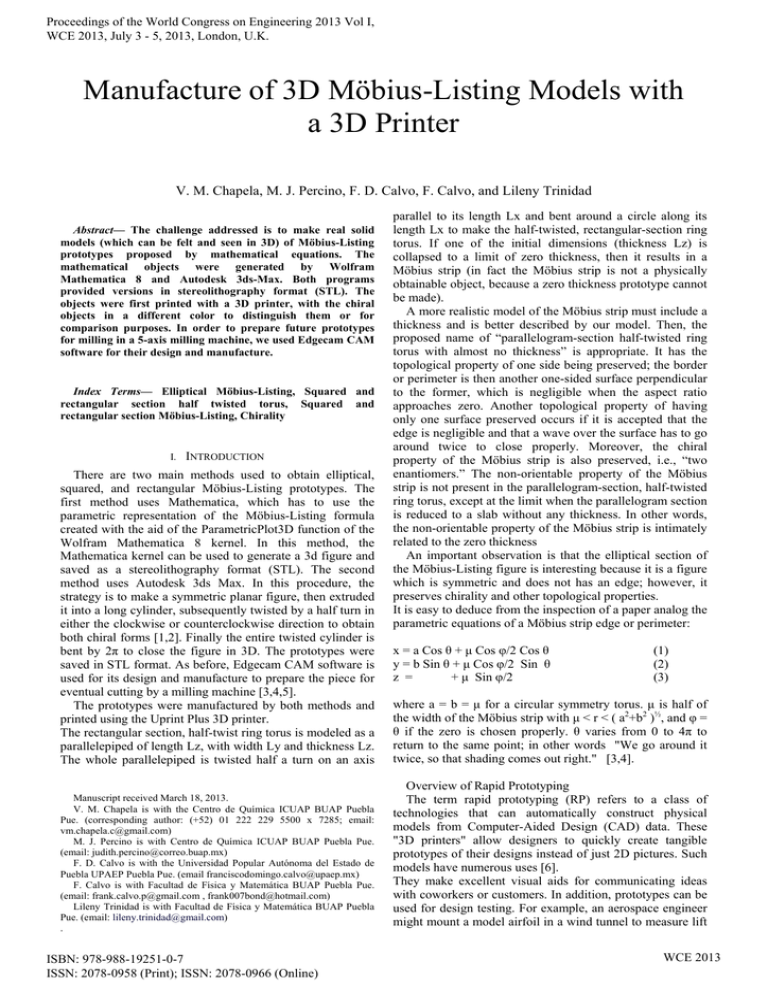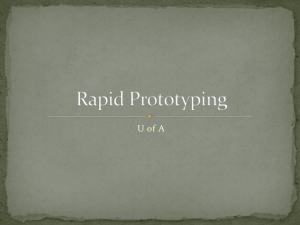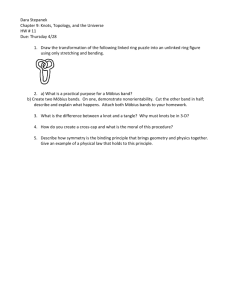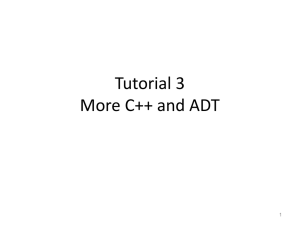
Proceedings of the World Congress on Engineering 2013 Vol I,
WCE 2013, July 3 - 5, 2013, London, U.K.
Manufacture of 3D Möbius-Listing Models with
a 3D Printer
V. M. Chapela, M. J. Percino, F. D. Calvo, F. Calvo, and Lileny Trinidad
Abstract— The challenge addressed is to make real solid
models (which can be felt and seen in 3D) of Möbius-Listing
prototypes proposed by mathematical equations. The
mathematical objects were generated by Wolfram
Mathematica 8 and Autodesk 3ds-Max. Both programs
provided versions in stereolithography format (STL). The
objects were first printed with a 3D printer, with the chiral
objects in a different color to distinguish them or for
comparison purposes. In order to prepare future prototypes
for milling in a 5-axis milling machine, we used Edgecam CAM
software for their design and manufacture.
Index Terms— Elliptical Möbius-Listing, Squared and
rectangular section half twisted torus, Squared and
rectangular section Möbius-Listing, Chirality
I.
INTRODUCTION
There are two main methods used to obtain elliptical,
squared, and rectangular Möbius-Listing prototypes. The
first method uses Mathematica, which has to use the
parametric representation of the Möbius-Listing formula
created with the aid of the ParametricPlot3D function of the
Wolfram Mathematica 8 kernel. In this method, the
Mathematica kernel can be used to generate a 3d figure and
saved as a stereolithography format (STL). The second
method uses Autodesk 3ds Max. In this procedure, the
strategy is to make a symmetric planar figure, then extruded
it into a long cylinder, subsequently twisted by a half turn in
either the clockwise or counterclockwise direction to obtain
both chiral forms [1,2]. Finally the entire twisted cylinder is
bent by 2π to close the figure in 3D. The prototypes were
saved in STL format. As before, Edgecam CAM software is
used for its design and manufacture to prepare the piece for
eventual cutting by a milling machine [3,4,5].
The prototypes were manufactured by both methods and
printed using the Uprint Plus 3D printer.
The rectangular section, half-twist ring torus is modeled as a
parallelepiped of length Lz, with width Ly and thickness Lz.
The whole parallelepiped is twisted half a turn on an axis
Manuscript received March 18, 2013.
V. M. Chapela is with the Centro de Química ICUAP BUAP Puebla
Pue. (corresponding author: (+52) 01 222 229 5500 x 7285; email:
vm.chapela.c@gmail.com)
M. J. Percino is with Centro de Química ICUAP BUAP Puebla Pue.
(email: judith.percino@correo.buap.mx)
F. D. Calvo is with the Universidad Popular Autónoma del Estado de
Puebla UPAEP Puebla Pue. (email franciscodomingo.calvo@upaep.mx)
F. Calvo is with Facultad de Física y Matemática BUAP Puebla Pue.
(email: frank.calvo.p@gmail.com , frank007bond@hotmail.com)
Lileny Trinidad is with Facultad de Física y Matemática BUAP Puebla
Pue. (email: lileny.trinidad@gmail.com)
.
ISBN: 978-988-19251-0-7
ISSN: 2078-0958 (Print); ISSN: 2078-0966 (Online)
parallel to its length Lx and bent around a circle along its
length Lx to make the half-twisted, rectangular-section ring
torus. If one of the initial dimensions (thickness Lz) is
collapsed to a limit of zero thickness, then it results in a
Möbius strip (in fact the Möbius strip is not a physically
obtainable object, because a zero thickness prototype cannot
be made).
A more realistic model of the Möbius strip must include a
thickness and is better described by our model. Then, the
proposed name of “parallelogram-section half-twisted ring
torus with almost no thickness” is appropriate. It has the
topological property of one side being preserved; the border
or perimeter is then another one-sided surface perpendicular
to the former, which is negligible when the aspect ratio
approaches zero. Another topological property of having
only one surface preserved occurs if it is accepted that the
edge is negligible and that a wave over the surface has to go
around twice to close properly. Moreover, the chiral
property of the Möbius strip is also preserved, i.e., “two
enantiomers.” The non-orientable property of the Möbius
strip is not present in the parallelogram-section, half-twisted
ring torus, except at the limit when the parallelogram section
is reduced to a slab without any thickness. In other words,
the non-orientable property of the Möbius strip is intimately
related to the zero thickness
An important observation is that the elliptical section of
the Möbius-Listing figure is interesting because it is a figure
which is symmetric and does not has an edge; however, it
preserves chirality and other topological properties.
It is easy to deduce from the inspection of a paper analog the
parametric equations of a Möbius strip edge or perimeter:
x = a Cos θ + μ Cos φ/2 Cos θ
y = b Sin θ + μ Cos φ/2 Sin θ
z =
+ μ Sin φ/2
(1)
(2)
(3)
where a = b = μ for a circular symmetry torus. μ is half of
the width of the Möbius strip with μ < r < ( a2+b2 )½, and φ =
θ if the zero is chosen properly. θ varies from 0 to 4π to
return to the same point; in other words "We go around it
twice, so that shading comes out right." [3,4].
Overview of Rapid Prototyping
The term rapid prototyping (RP) refers to a class of
technologies that can automatically construct physical
models from Computer-Aided Design (CAD) data. These
"3D printers" allow designers to quickly create tangible
prototypes of their designs instead of just 2D pictures. Such
models have numerous uses [6].
They make excellent visual aids for communicating ideas
with coworkers or customers. In addition, prototypes can be
used for design testing. For example, an aerospace engineer
might mount a model airfoil in a wind tunnel to measure lift
WCE 2013
Proceedings of the World Congress on Engineering 2013 Vol I,
WCE 2013, July 3 - 5, 2013, London, U.K.
and drag forces. Designers have always used prototypes; RP
allows them to be made faster and less expensively.
In addition to prototypes, RP techniques can be used to
make tooling (referred to as rapid tooling) and even
production-quality parts (rapid manufacturing). For small
production runs and complicated objects, rapid prototyping
is often the best manufacturing process available. Of course,
"rapid" is a relative term. Most prototypes require from 3–
72 hours to be made, depending on the size and complexity
of the object. This may seem slow, but it is much faster than
the weeks or months required to make a prototype by
traditional methods such as machining. These dramatic time
savings allow manufacturers to bring products to market
faster and less expensively. In 1994, Pratt & Whitney
achieved "an order of magnitude [cost] reduction [and] time
savings of 70 to 90 percent" by incorporating rapid
prototyping into their investment casting process.
II. THE BASIC PROCESS
Although several rapid prototyping techniques exist, all
employ the same basic six-step process. The steps are:
1. Generate a mathematical model Mathathica program
2. Create a CAD model of the design
3. Convert the CAD model to STL format
4. Slice the STL file into thin cross-sectional layers
5. Construct the model one layer atop another
6. Clean and finish the model
Generate mathematical model with Mathematica:
Mathematica has to use the parametric representation of the
formula of Möbius-Listing perimeter, and with the aid of the
ParametricPlot3D function in the Mathematica 8 kernel, the
STL (stereolithography format) can be generated (STL
being an acronym derived from stereolithography) [7].
CAD Model Creation: The object to be built is modeled
using a Computer-Aided Design (CAD) software package.
Solid modelers, such as Pro/ENGINEER, tend to represent
3D objects more accurately than wire-frame modelers such
as AutoCAD, and therefore they yield better results. The
designer can use a pre-existing CAD file or can create one
expressly for prototyping purposes. This process is identical
for all of the RP build techniques.
Conversion to STL Format: The various CAD packages
use a number of different algorithms to represent solid
objects. To establish consistency, the STL format has been
adopted as a standard in the rapid prototyping industry. The
next step, therefore, is to convert the CAD file into STL
format. This format represents a 3D surface as an assembly
of planar triangles, "like the facets of a cut jewel." The file
contains the coordinates of the vertices and the direction of
the outward normal of each triangle. Because STL files use
planar elements, they do not exactly represent curved
surfaces. Increasing the number of triangles improves the
approximation, but at the cost of a larger file size. Large,
complicated files require more time to pre-process and
build, so the designer must balance accuracy with
manageability to produce a useful STL file. Since the STL
ISBN: 978-988-19251-0-7
ISSN: 2078-0958 (Print); ISSN: 2078-0966 (Online)
format is universal, this process is identical for all RP build
techniques.
Slice the STL File: In the fourth step, a pre-processing
program prepares the STL file for the build. Several
programs are available, and most allow the user to adjust the
size, location, and orientation of the model. Build
orientation is important for several reasons. First, the
properties of rapid prototypes vary from one coordinate
direction to another. For example, prototypes are usually
weaker and less accurate in the z- (vertical) direction than in
the x-y plane. In addition, the orientation of a part partially
determines the amount of time required to build the model.
Placing the shortest dimension in the z-direction reduces the
number of layers, thereby shortening the build time. The
pre-processing software slices the STL model into a number
of layers ranging from 0.01 mm to 0.7 mm thick depending
on the build technique. The program may also generate an
auxiliary structure to support the model during the build.
These supports are useful for delicate features such as
overhangs, internal cavities, and thin-walled sections. Each
PR machine manufacturer supplies their own proprietary
pre-processing software.
Layer by Layer Construction: The fifth step is the
actual construction of the part. Using one of several
techniques, the RP machines build one layer at a time from
polymers, paper, or powdered metal. Most machines are
fairly autonomous, needing little human intervention.
Clean and Finish: The final step is post-processing. This
involves removing the prototype from the machine and
detaching any supports. Some photosensitive materials need
to be fully cured before use. Prototypes may also require
minor cleaning and surface treatment. Sanding, sealing,
and/or painting the model will improve its appearance and
durability.
Fused Deposition Modeling (FDM): In this technique,
filaments of heated thermoplastic are extruded from a tip
that moves in the x-y plane. Like a baker decorating a cake,
the controlled extrusion head deposits very thin beads of
material onto the build platform to form the initial layer. The
platform is maintained at a lower temperature so that the
thermoplastic quickly hardens. After the platform lowers,
the extrusion head deposits a second layer upon the first.
Supports are built along the way and fastened to the part
either with a second, weaker material or with a perforated
junction.
Stratasys, of Eden Prairie, MN makes a variety of FDM
machines ranging from fast concept modelers to slower,
high-precision machines. Materials include acrylonitrile
butadiene styrene (ABS; standard and medical grade),
elastomer
(96
durometer),
polycarbonate,
polyphenolsulfone, and investment casting wax.
WCE 2013
Proceedings of the World Congress on Engineering 2013 Vol I,
WCE 2013, July 3 - 5, 2013, London, U.K.
III. RESULTS
After the shapes were 3D printed, the figures were
compared and photographed. The figures are provided here
and mainly show the topological properties discussed above,
i.e., chirality with one of the sides collapsed to the Möbius
perimeter. The non-orientable property is just observed in
the thickness limit. Also, the C2 symmetry is self-evident.
Fig. 1. Schematic diagram of fused deposition modeling.
Fig. 4. Twisted torus from squared section to Möbius–Listing quadrangular
section.
IV. CONCLUSION
From the manufacture of these models one can deduce
that it is possible to mill machine models for other
experimental purposes, including for superconducting
experiments and to measure the magnetic field around a
magnetized Möbius-Listing model and electrical field of
charged Möbius-Listing charge with electrons to measure
the electric field around the Möbius–Listing model.
The present work was made as preparation for milling
using a 5-axis milling machine.
REFERENCES
[1]
[2]
[3]
[4]
[5]
Fig. 2. Rapid prototype machine, exterior and interior.
[6]
[7]
Moebius Strip as a Half Twisted Square Torus
http://demonstrations.wolfram.com/MoebiusStripAsAHalfTwistedSq
uareTorus/
Twisted polygonal cross section Tori Demostration
http://demonstrations.wolfram.com/TwistedPolygonalTorus/
Wolfram Research, Inc., Mathematica, Version 7.0, Champaign, IL
(2008).
Mathematica Version: Mathematica 2.0
Package Version: 1.1. Title: Shapes of Common 3D Solids Author:
Roman Maeder
Edgecam User Guide, Copyright© 1988 – 2008. Pathtrace All Rights
Reserved.
Pandey, P.M., Reddy N.V., “Slicing Procedures in Layered
Manufacturing”, Dhande, S.G. (2003), Rapid Prototyping Journal,
Vol. 9 Iss:5, pp. 274-288.
Singhal, S.K., Pandey, A.P., Pandey, P.M., Nagpal, A.K. Optimum
Part Deposition Orientation in Stereolithography, Computer Aided
Design and Applications, 2005, vol. 2, pp. 1-4.
Fig. 3. Material bag used for printing.
ISBN: 978-988-19251-0-7
ISSN: 2078-0958 (Print); ISSN: 2078-0966 (Online)
WCE 2013





